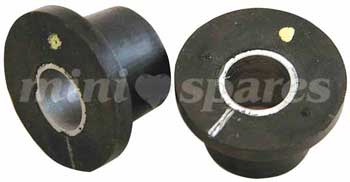
Aftermarket bushes for suspension and subframes have been a topic of conversation for some time now. Many folk have become obsessed about fitting brightly coloured plastic (polyurethane) bushes in place of any rubber bush they can find in the belief they will improve the performance of whatever bush has been replaced. Whilst it is true that polyurethane is harder wearing - and therefore longer lasting - than rubber in many applications it is not necessarily the best material for the application every time. Polyurethane has greater abrasion resistance and is stiffer for a similar hardness, is much cheaper to produce (and therefore sells at lower cost) and can be produced in a wide variety of gaudy colours.
However, it does not posses the elasticity, vibration absorbance or deflection tolerance of rubber, pretty much why manufacturers use rubber on production cars instead of the cheaper polyurethane. A case in point (and what brought this subject to the fore) is bottom arm bushes used in competition where spherical rod ends are not allowed. Increasing the caster angle to improve handling distorts the inner bottom arm bush dramatically. The more caster angle used, the more dramatic the distortion. Whilst a rubber bush will tolerate this to a certain extent, a polyurethane bush will deform and stay deformed - adversely affecting the bush's performance and eventually failing in an unwanted - and possibly dramatic way - by falling out, split into several pieces. Ideally a rubber bush with a metal sleeve in it to reduce the quantity of rubber in the installation to improve stability and control is the way to go; especially if that metal insert is offset at an angle in the rubber to counter or reduce the deflection applied by greater caster angles than standard.
And that is exactly what Mini Spares have come up with after protracted investigation into materials, suitability and performance. The new offset performance bushes are available in 80 or 90 IRHD rubber for fast road/competition and race use respectively. Although being a little more expensive than the plastic alternatives they will do a far superior job for longer.
C-STR631 - 90IRHD (white identification dot) hard bush for race use
C-STR632 - 80IRHD up-rated bush (yellow identification dot) for fast road/competition use
Fitting:
In both cases the bushes need to be properly orientated to achieve the correct angle of fitment for the offset steel sleeves. The bushes are therefore marked with a fine line on the narrower side of the bush flange (check top and underside of flange). The front bush (nearest front of car) should be fitted with this line pointing down the centerline of the bottom arm towards the wheel. The rear bush should be positioned with it's line 180 degrees the other way, so pointing in towards the centerline of the car. Trial fit the bushes and bottom arm pin to the arm before fitting to the car - the pin should fit easily through. If the bushes are not correctly aligned the pin will not fit easily.